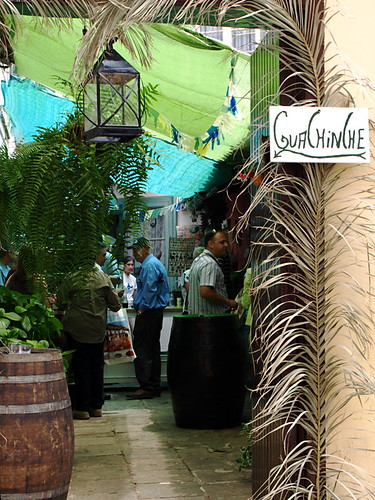Guachinche – what a delicious sounding word, pronounced as far as I can ascertain as gwah-cheen-chay with the G so soft it’s like a whisper on the wind that you aren’t quite sure you actually heard.
We’d seen references to these all over the place when we first moved to Tenerife, but for a couple of years weren’t exactly sure of what they were and thought they were basically just roadside restaurants serving traditional Canarian cooking. Wrong, wrong and wrong again.
Guachinches are rough ‘n’ ready makeshift restaurants that are often set up in someone’s garage, but they can pretty much turn up anywhere – in the middle of banana plantations, in someone’s courtyard, in gardens.
Our first visit to a guachinche put us straight as to what one actually looked like. A friend led us through a maze of huertas (vegetable allotments) in Tacoronte to a shed where chunky wooden tables were laid out like an ordinary restaurant. But this was no ordinary restaurant; this was back of beyond and then some. There wasn’t even a sign identifying it as a guachinche – you had to know it existed to find it. But it was packed out with people. Over the course of the afternoon we were brought a selection of wonderful home-cooking that ranged from ceviche (marinated uncooked fish) to papa rellena (crispy deep fried potato filled with mince) without being asked what we wanted. I think the bill came to about €10 a head including beer, wine and water.
That first guachinche was a Peruvian one and was frequented by mainly residents with some connection to Peru. Since then every other one I’ve been to has been Canarian and has generally featured pinchos (seasoned pork on skewers), rancho canario, escaldons and boiled eggs…there are always boiled eggs. They all sell wine from their own vineyard.
The origins of guachinches might not be what you think. I’d always believed the word to have Guanche origins, but apparently not. It’s a bastardisation of English and dates from a time when English merchants used to buy wine and produce direct from country folk (magos) in the hills above the north coast. As the magos prepared the order, the English merchants would say ‘I’m watching you’. Whether that was out of interest or to make sure they weren’t being short-changed is unclear but over time ‘wat-ching-you’ became ‘ gwah-cheen-chay’.
They’re quite unique to Tenerife, although Gran Canaria has a variation of them. The other weekend whilst walking through the plantations with a friend from La Gomera we passed one which was about as uninviting looking a guachinche as I’ve seen – behind a high wall topped with barbed wire – although the laughter and lively buzz from behind the wall showed it was a popular one. Our friend had never seen one on La Gomera.
At fiestas and wine harvest, guachinches spring up all over the place. During the rest of the year they can be found in numbers on Tenerife’s northern slopes. There are some around Güímar, Arico, and Arafo but the further south you go, their numbers diminish as they are linked to a tradition that was specific to the north of Tenerife. The best place to find them is between Tacoronte and Los Realejos
Some you’ll never find unless you’re told about them, others can be found by following signs scrawled on cardboard nailed to trees. Restaurants that call themselves ‘guachinches’ are playing free and easy with the term and are generally aimed more at ‘visitors’ than residents. Real bona fide guachinches offer a completely different dining experience – one that is raw and about as authentic Tenerife as you can get. This is Tenerife dining for real travellers.
Once unregulated, guachinches are now bound by certain laws. They should only open for three consecutive months, offer a maximum of three dishes (none of which should be dessert or fruit) and serve only their own wine – they aren’t even allowed to serve beer, coffee or tea but they can sell water.
I’ve yet to be in one that stuck exactly to this but that’s part of what makes eating in one fun, they have a certain illicit atmosphere, like drinking at an illegal still in the forest. Just writing about them has made me yearn for a guachinche hit. Luckily we’ve got two within walking distance…buen provecho.







I love these places, and I never knew about the origin of the word – love that I learn more about this island each day that passes!
Brilliant isn’t it? Who’d have ever thought it came from English? I’d never have gotten close in a million years. But the more I say the two (especially the way a Spanish person would say watching you) the more I can see it.
Jack, thank you so much for sharing your experience. It’s true that nowadays, many restaurants call themselves “guachinches,” but often they have very little in common with true Tenerifean tradition. In our directory, https://guachinchestenerife.com, we explain the difference between authentic guachinches and regular restaurants. We keep information about their locations and working hours up to date, and real visitors leave their genuine reviews.